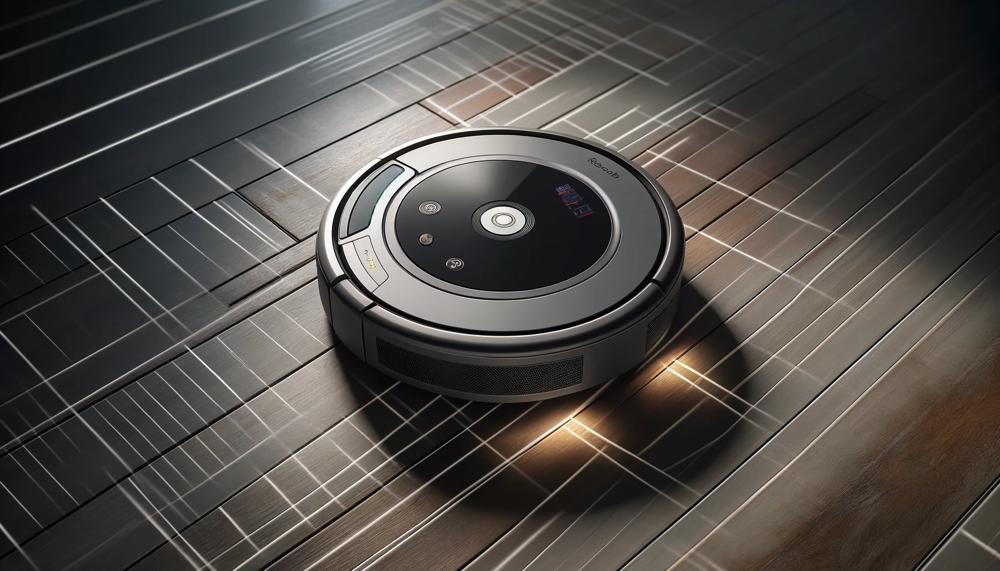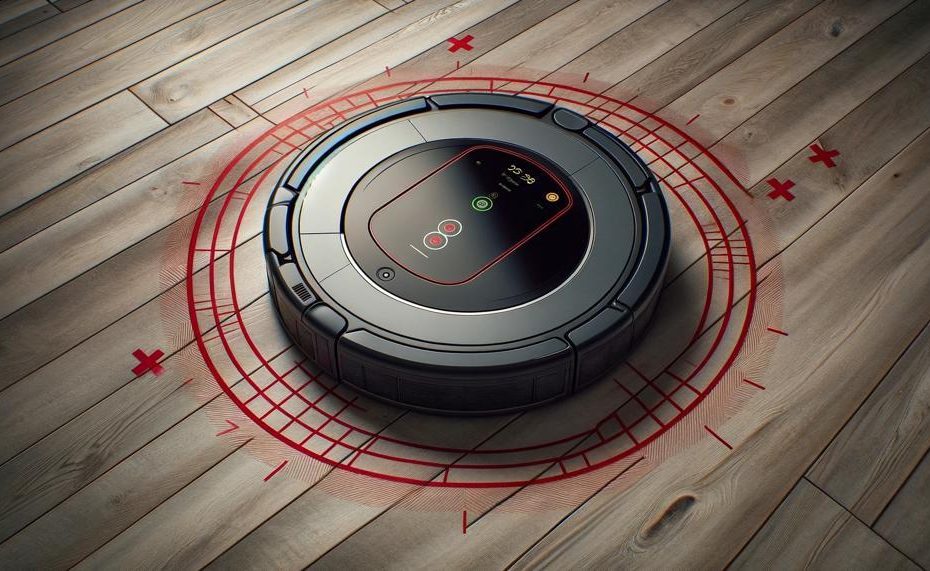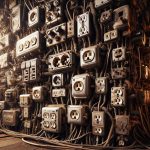Do you ever wonder why your floors have strange marks after using your trusty Roomba? Many Roomba users have reported this issue, leaving them puzzled and frustrated.
After all, we rely on our robot vacuums to keep our floors clean and free of blemishes.
So why is it leaving behind these unsightly marks? In this blog post, we’ll explore the reasons behind Roomba’s mark-making tendencies and provide some helpful tips on how to prevent and remove them.
So, why is roomba leaving marks on the floor?
Your Roomba might be leaving marks on the floor due to a few reasons:
- Dirty tracked wheels: If your Roomba is leaving one or two straight marks on the floor, then the tracked wheels are most likely dirty. Dirt and dust can accumulate on the tracked wheels and once clogged dirt gets in contact with any liquid, the tracked wheels can leave scuff marks on the floor. To fix this, check whether the Roomba tracked wheels are dirty. If there’s any dirt or dust, clean the wheels immediately using rubbing alcohol wipes.
- Stuck front caster wheel: A worn-out front caster wheel can cause your Roomba vacuum to leave dirt traces. You might need to remove and replace the Roomba’s front caster wheel.
- Full dustbin: A full dustbin can also cause your Roomba vacuum to leave dirt traces.
- Clogged dirt on the gaps: If there’s dirt on the gaps of your Roomba unit, it can fall off once your Roomba starts running. And when that happens, the tracked wheels can “press” the dust on the floor, which results in unwanted dirt markings1. To resolve this, clean the bottom surface of your Roomba unit, especially the gaps on it.
- Worn out or improperly installed brushes: The brushes could be worn out, damaged, or not properly installed.
Contents
- 1 Reasons Why Roomba Leaving Marks On The Floor
- 2 Reasons Why Robot Vacuums May Damage Or Scratch Hardwood Floors
- 3 How To Fix Roomba Leaving Marks On The Floor?
- 4 How Do I Stop My Vacuum From Scratching The Floor?
- 5 Is Your Roomba Dragging Items Under It?
- 6 Is it OK to use a Roomba on hardwood floors?
- 7 Does Roomba leave lines on the carpet?
- 8 Conclusion
Reasons Why Roomba Leaving Marks On The Floor
Are you noticing marks on your floors after using your Roomba? Here are a few possible reasons why:
- Dirty Tracked Wheels: Over time, the wheels of your Roomba can become dirty and track that dirt onto your floors, leaving unpleasant marks behind.
- Stuck Front Caster Wheel: If the front caster wheel of your Roomba gets stuck, it can cause it to drag and leave marks on your floors.
- Clogged Dirt in Gaps: The gaps and crevices of your Roomba can become clogged with dirt and debris, leading to marks left on your floors as it moves around.
- Worn-Out or Damaged Front Caster Wheel: A damaged or worn-out front caster wheel can also cause your Roomba to leave marks on your floors.
- Full Dustbin: An overflowing dustbin can cause debris to spill out as the Roomba moves, resulting in marks on your floors.
- Regularly clean and maintain your vacuum: The most crucial step in preventing scratches is to regularly clean and maintain your robot vacuum. This includes cleaning the wheels and bottom surface, checking for any stuck debris, replacing worn-out parts, and emptying the dustbin.
- Use virtual walls or barriers: Most robot vacuums come equipped with virtual walls or barriers that you can utilize to block off certain areas of your home. If you have a space with delicate flooring, simply set up a virtual wall or create a makeshift barrier using items like shoes or books to prevent the vacuum from entering that area.
- Rid the area of clutter: To help your robot vacuum clean efficiently without running into obstacles, make sure to move any clutter out of the way or into the center of the room.
- Check and clean the extractors and brushes: The extractors and brushes on your robot vacuum can easily pick up dirt and debris, which can then scratch your floors if not cleaned regularly. Check them frequently and clean them as needed to prevent any buildup.
- Keep rooms well-lit: Robot vacuums use sensors to navigate around your home, so keeping your rooms well-lit can help them perform at their best. This will also prevent any accidental collisions with furniture or walls.
- Consider multiple vacuums for multiple levels: If you have multiple levels in your home with different types of flooring, consider purchasing a cheaper robot vacuum for each level. This will prevent any potential damage from using one vacuum on different types of flooring.
- Use your vacuum frequently: Finally, using your robot vacuum frequently can help prevent any buildup of dirt or debris that can lead to scratches. Aim to use it at least a few times a week for optimal results.
- Stuck debris or tangled hair in the brushes: Remove the stuck debris or tangled hair from the brushes.
- Jammed Roomba wheels: Check for the jammed wheel and remove anything stopping them from rotating freely.
- Roomba broken piece getting dragged on the floor: Check for any broken Roomba parts and replace them with a new one.
- Secure rug edges: Make sure your rug’s edges are flat and not curled up. This will enable the Roomba to move smoothly without getting caught on the edges.
- Remove obstructions: Clear any objects or obstacles from the rug that could hinder the Roomba’s movement. This includes things like small furniture, toys, or other items that may get in the way.
- Customize cleaning schedules: Roombas allow you to customize their cleaning schedules, so consider adjusting them to avoid repeatedly cleaning the same area. This can help prevent lines from forming on your carpets.
- Use barriers or virtual walls: For thicker or delicate rugs, consider using physical barriers or virtual walls to limit the Roomba’s access to those areas. This will prevent it from cleaning over the same spot and potentially causing lines on your carpets.
- Consider alternative cleaning methods: If you have shaggy or high-pile rugs, it may be best to use a traditional vacuum cleaner or professional cleaning service instead of a Roomba. This will prevent any potential damage or tangling of the robot on these types of rugs.
Other Factors to Consider
In addition to these potential causes, there are other factors that may contribute to marks left by your Roomba.
These include the type of flooring in your home, the length of time your Roomba spends in one area, and the age and model of your Roomba.
Tips for Preventing Marks on Your Floors
To help prevent these marks from occurring, regular maintenance and proper usage of your Roomba are key. Keep the wheels clean and free from debris, make sure the front caster wheel is functioning properly, and regularly empty the dustbin.
Additionally, try not to leave your Roomba in one area for too long, especially if you have softer flooring that is more prone to marks.
With proper care and maintenance, your Roomba should leave your floors clean and mark-free. Take the time to regularly check and clean your Roomba to ensure it is functioning at its best and keep an eye out for potential issues that may cause marks on your floors.
Reasons Why Robot Vacuums May Damage Or Scratch Hardwood Floors
Improper use on carpets or rugs
Robot vacuums, such as the popular Roomba, are specifically designed for use on hard floors like hardwood, tile, and laminate.
However, if used on carpets or rugs, the rotating brushes can create friction and leave marks or scratches on the floor.
Accumulation of debris and hair on wheels
Over time, debris and hair can become tangled around the wheels of a robot vacuum, causing them to become less smooth.
This can result in the wheels leaving marks on the floor as they move around.
Prolonged duration in one location
Unlike traditional vacuum cleaners that follow a linear pattern, robot vacuums use a random algorithm to navigate and clean a room. As a result, they may spend more time in certain areas, leading to excessive wear and tear and potentially leaving behind marks.
Age and model of the robot vacuum
Older models of robot vacuums may not have updated sensors or technology to prevent marks from occurring. It is also important to note that certain models may be specifically designed for carpets and may not perform as well on hard floors, resulting in marks being left behind.
To avoid damage or scratches on your hardwood floors due to robot vacuums, it is crucial to use them appropriately on designated hard floors, regularly clean and maintain the wheels, limit prolonged duration in one area, and consider the age and model of your robot vacuum.
How To Fix Roomba Leaving Marks On The Floor?
There is nothing more frustrating than discovering marks on your floor after using your Roomba. To prevent this issue, consider following these solutions:
Keep the tracked wheels clean
Roomba’s tracked wheels can easily gather debris and hair over time, resulting in less smooth operation and potential marks on the floor.
It is important to regularly clean these wheels with a small brush or toothbrush to remove any tangled debris.
Check for stuck debris in the wheels
In addition to cleaning the wheels, it is also crucial to check for any debris or hair stuck in the center of the wheels.
This can cause unnecessary friction and leave marks on the floor. Use tweezers or a toothpick to carefully remove any debris.
Clean the bottom surface of Roomba
The bottom surface of your Roomba can also accumulate dirt and debris, potentially leading to marks on the floor.

It is recommended to regularly clean this area and remove any clogged dirt using a cloth or small brush.
Replace worn-out front caster wheel
A worn-out front caster wheel can cause extra friction and ultimately leave marks on your floors.
It is advised to replace this wheel every 12 months for optimal performance and to prevent any marks from appearing.
Regularly empty dustbin
A full dustbin can put extra pressure on Roomba’s wheels, resulting in marks being left on the floor. It is essential to empty the dustbin when it becomes full. Simply use the release tab to remove the dustbin and empty it before continuing use.
By implementing these solutions and regularly maintaining your Roomba, you can avoid marks being left on your floors and enjoy a clean and smooth surface.
How Do I Stop My Vacuum From Scratching The Floor?
If you are a proud owner of a Roomba or other robot vacuum, you may have noticed some unsightly scratches or scuffs on your floors. These can not only be an eyesore, but also cause damage to your flooring over time.
Luckily, there are some simple and practical methods you can implement to prevent these scratches and keep your floors looking pristine.
Protecting Your Floors from Scratching The Floor
Is Your Roomba Dragging Items Under It?
Yes, if your Roomba is dragging items under it, this can cause it to leave marks on your floor1. From kids and dog toys, to even dog poop, it can get stuck under your robot vacuum and leave marks on your floors as it cleans1.
Here are some possible reasons and solutions:
If these solutions don’t work, you might want to contact iRobot’s customer service for further assistance. Remember, regular maintenance and cleaning of your Roomba can prevent such issues.
Is it OK to use a Roomba on hardwood floors?
Using a Roomba to clean hardwood floors can be a convenient time-saver, but there are some potential downsides to consider.
Additionally, the Roomba’s movement patterns may lead to scratches or scuffs on the floors.
Does Roomba leave lines on the carpet?
When using a Roomba to clean your carpets, be aware that its circular motion and overlapping cleaning paths can leave visible lines on the surface. These lines may be more noticeable on certain types of rugs, like high-pile or shaggy rugs.
To avoid this issue, there are several key steps you can take:
Conclusion
To sum up, Roomba’s strange problem of leaving marks on floors has made a lot of users angry.
These ugly marks seem to come out of nowhere, even though we depend on our robot vacuums to keep our floors clean. However, Roomba’s complicated design and physics mean that there are some things that can make it more likely to leave marks.
Some of these include dirty wheels, full holes, and a full trash can. To fix this problem, you must give your Roomba regular care and use it correctly.
For people with wooden floors, it’s also important to know that scratches can happen from older models or bad use. You can ensure that your Roomba leaves your floors spotless and free of marks by following useful tips such as keeping the wheels clean, using virtual walls or hurdles, and frequently cleaning the trash can.
When cleaning carpets or rugs, homeowners can avoid seeing lines by taking steps such as securing the edges of the rug and removing any obstacles.





